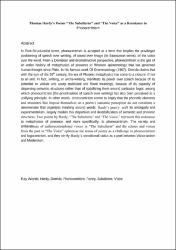Thomas Hardy’s Poems “The Subalterns” and “The Voice” as a Resistance to Phonocentrism
Özet
In Post-Structuralist terms, phonocentrism is accepted as a term that implies the privileged positioning of speech over writing, of sound over image (in Saussurean terms), of the voice over the word. From a Derridean and deconstructive perspective, phonocentrism is the gist of an entire history of metaphysics of presence in Western epistemology that has governed human thought since Plato. In his famous work Of Grammatology (1967), Derrida claims that with the turn of the 20 th century, the era of Platonic metaphysics has come to a closure, if not to an end. In fact, writing, or arche-writing, manifests its power over speech because of its potential to violate and usurp stabilized and fixed meanings, because of its capacity of dispersing semantic structures rather than of stabilizing them around particular logoi, among which phonocentrism (the prioritisation of speech over writing) has also been perceived as a unifying principle. In other words, phonocentrism comes to imply that the phonetic elements and structures that impose themselves on a poem's semantic perception do not constitute a denominator that organizes meaning around words. Hardy's poetry, with its ambiguity and experimentalism, largely models this dispersion and destabilization of semantic and phonetic structures. Two poems by Hardy, "The Subalterns" and "The Voice," represent this resistance to metaphysics of presence, and more specifically, to phonocentrism. The variety and ambivalence of anthropomorphised voices in "The Subalterns" and the echoes and voices from the past in "The Voice" epitomise the status of poetry as a challenge to phonocentrism and logocentrism, and they verify Hardy's transitional status as a poet between Victorianism and Modernism.
Kaynak
BICOASP-Bandırma Onyedi Eylül Üniversitesi 2nd International Congress on Academic Studies in PhilologyBağlantı
https://bicoasp.bandirma.edu.tr/tr/bicoasp/Sayfa/Goster/BICOASP-2019-PUBLICATIONS-2339https://hdl.handle.net/20.500.11857/1397



















